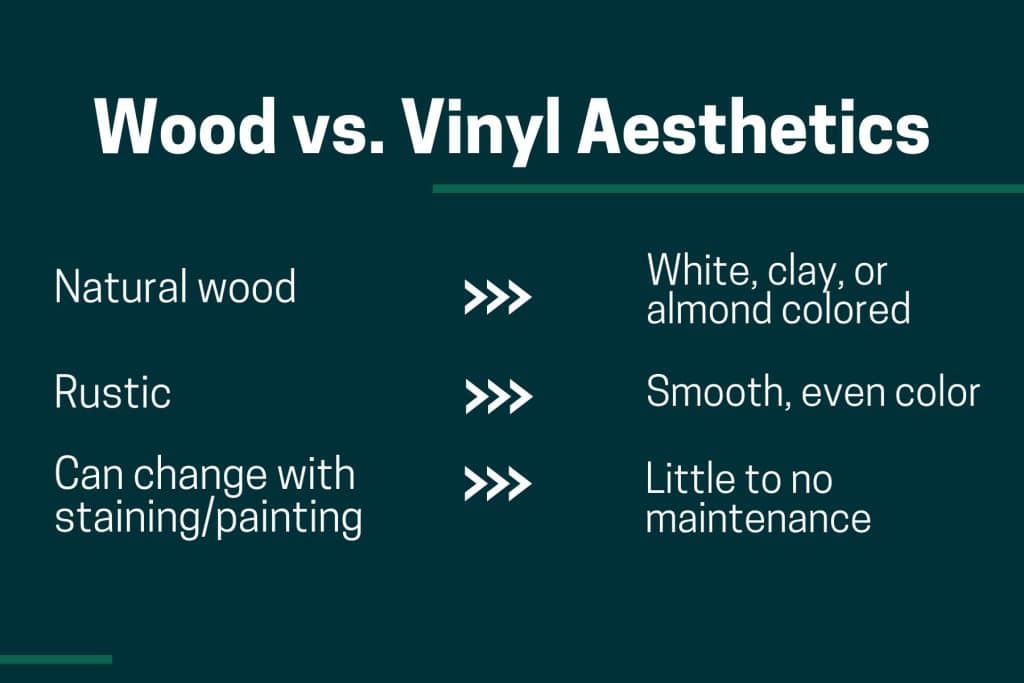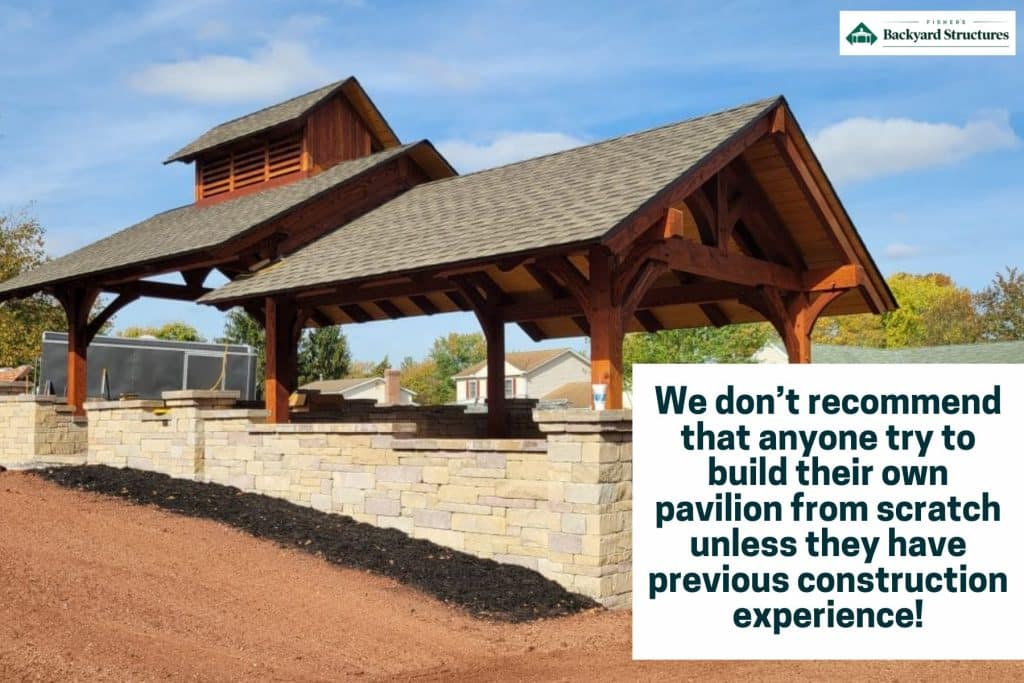How to Choose Between Wood and Vinyl Pavilions for Your Outdoor Space
If you've ever dreamed of adding a beautiful and functional outdoor living space to your backyard, you've probably considered purchasing a pavilion.
But there are various types of pavilions available, and you may find yourself stuck on one simple conundrum:
Should you go with a wood pavilion or a vinyl pavilion?
At Fisher’s Backyard, we build both wood and vinyl pavilions, and we’re well-versed in the pros and cons of each.
That’s why we’ve written this article!
We’d like to take you through the ins and outs of wood and vinyl pavilions so you can determine which option is right for you.
What Is a Pavilion?
A pavilion is an outdoor living structure with a roof supported by posts. It’s traditionally placed in an outdoor living area such as a backyard or garden and provides shade and shelter from inclement weather.
Pavilions offer the perfect outdoor space to host friends or events, gather with family, or relax in nature – rain or shine!
Although it has a practical function, a pavilion should also enhance the looks of your outdoor space. Thankfully this isn’t hard to do with some paint or stain and small decorative features. If you want to take it to the next level, you can always add other things as well, like a trellis for a climbing vine or shrubs and flowers around the pavilion.
And when it comes to getting a pavilion on your property, you have options!
Some people like to design and make their pavilions, while some prefer to purchase ready-made ones. The most popular option is to buy a pavilion kit so that you can choose what size, add-ons, and colors you’d like, and then you or your contractor can put it together.
Many pavilion builders give you two options for the structure material of the pavilion: wood or vinyl. Vinyl pavilions are not made purely from vinyl – instead, they’re made from wood and then coated in vinyl, similar to a house with vinyl siding. This blog will explore which option is right for you.
(To learn more about designing pavilions, read our blog post about Designing the Backyard Pavilion of Your Dreams!)
Wood vs. Vinyl: Cost Differences
Vinyl pavilions tend to be more expensive up-front than wood pavilions. A standard 12’x16’ vinyl pavilion typically starts at about $9860.00 before shipping and installation costs, while a wood pavilion of the same size and shape will be around $8590.00.
However, over time, the costs even out.
How?
Vinyl is virtually maintenance-free compared to wood, which requires periodic painting or staining. Because of this, wood costs more for year-to-year maintenance if you add up the cost of time and materials.
Ultimately, the total cost comes down to how much you dread maintenance tasks. If it’s a fun hobby for you, wood may still end up being cheaper. But if it’s a dreaded chore, or if you’ll be hiring someone to do it for you, vinyl might be the more affordable option.
Wood vs. Vinyl: Durability
Vinyl siding rose to popularity in the 1970s as a more durable alternative to wood, and its popularity today is due to the same thing: its low-maintenance durability.
Since vinyl is a synthetic material, it’s highly resistant to weather, pests, and rot. That means once you buy it, it’s virtually maintenance-free!
Wood, on the other hand, requires a lot of TLC. It’s susceptible to rot, warping, and insect damage and requires regular maintenance to prevent and mitigate this damage. However, well-maintained wood can last just as long as a vinyl pavilion; it just takes much more work.
And, of course, durability is just one factor to consider! While vinyl is the better option when it comes to durability, wood stands out in other areas.
Let’s look at a few more things to consider!

Wood vs. Vinyl: Aesthetics
For many, the choice of wood vs. vinyl will come down to looks. What looks beautiful to you? What aesthetic are you going for?
Wood pavilions may be a better option if:
- You like the look of natural wood
- You’re going for a more rustic look
- You’d like to be able to change the look periodically by re-staining or re-painting
On the other hand, you may prefer vinyl if:
- You like the look of a white, clay, or almond-colored pavilion
- You want something with a smooth, even color
- You want something that consistently looks nice while being virtually maintenance-free
Pro tip: What are you hoping to use your pavilion for? Nailing that down can go a long way toward figuring out what look is best for you. If you host a lot of events, a low-maintenance, pristine white pavilion may be your best choice. But if you'd like a quiet escape into nature, rustic wood may fit the mood better.

Wood vs. Vinyl: Environmental Impact
If you’re worried about environmental impact, you may think that a wooden pavilion is a better option than a vinyl pavilion. After all, wood is a biodegradable and renewable resource, and vinyl is not.
While that is certainly true, here are a couple of other factors to keep in mind:
- Not all wood is sustainably sourced.
- Vinyl, while it’s not biodegradable, can be recycled.
Still, your best option for low environmental impact is to buy a wooden pavilion that’s been sustainably sourced from locally-grown wood and use eco-friendly paints and stains.
Installation and Assembly
Both wood and vinyl pavilions come in kits that are reasonably simple to assemble, with pre-cut pieces and pre-drilled holes.
The smaller and simpler the design, the easier it will be to assemble. Since vinyl pavilions have wooden pieces under the vinyl wrapping, the installation is roughly the same difficulty level as its wooden counterpart.
Of course, if you choose to build a pavilion from scratch, this entire process becomes exponentially more complicated. You’ll need to get careful lumber measurements, fasteners, cement for stabilizing the post, tools, and more.
In fact, we don’t recommend that anyone try to build their own pavilion from scratch unless they have previous construction experience.
If you're looking for more information on pavilion kits, we explored this process further in our Simple Guide to Pavilion Kits!

Other Customization Options to Consider
Remember: there’s a lot more that goes into your choice of pavilion than the choice of wood vs. vinyl! To get a pavilion that’s truly right for you, here are some other factors to consider.
Size
Pavilions come in a variety of custom sizes, from small 10x10 structures that can be nestled unobtrusively in a quiet corner of the lawn to large 20x40 pavilions where you can host events.
To determine what size you’d like, consider:
- How the proportions will relate to other parts of your lawn
- What sorts of things you’d like to use it for
- What size of pavilions you’re typically drawn to
Style
It’s also important to think about the pavilion’s style. When choosing a pavilion for your backyard, your style options include:
- Traditional – go classic or go home!
- A-frame – keep it simple
- Alpine Wood – when you want something a little more rustic
- Santa Fe – a pergola-inspired look perfect for gardens
- Grand Estate – great for hosting
- Hampton – refined and classy
Add-on Features
Finally, you can customize your pavilion by choosing to add:
- A cupola
- Shade curtains
- An electrical package
- Your choice of vinyl or stain colors
- Privacy walls
If these decisions feel overwhelming, don’t worry! We have a fantastic pavilion designer tool that helps you get a sense of what these options look like when all together. You can literally see exactly what you are getting before paying a dime!

Conclusion
At Fisher’s Backyard Structures, we can’t wait to make you the pavilion that completes your outdoor space.
Purchasing a pavilion from Fisher’s Backyard Structures is as easy as 1-2-3-4!
- Use our online tool to design your pavilion.
- We’ll send you a quote based on your design.
- After receiving the down payment, we’ll schedule and install your pavilion.
- Enjoy your beautiful new pavilion!
Besides wood and vinyl pavilions, we also make:
If you have any additional questions about pavilions in general, the differences between wood and vinyl, or any other questions about our products, contact us today!
We look forward to hearing from you.







